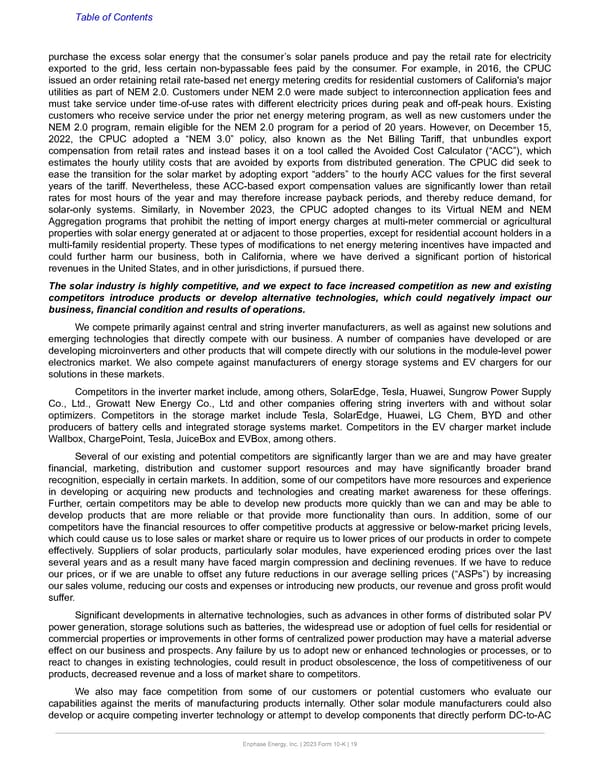Table of Contents purchase the excess solar energy that the consumer’s solar panels produce and pay the retail rate for electricity exported to the grid, less certain non-bypassable fees paid by the consumer. For example, in 2016, the CPUC issued an order retaining retail rate-based net energy metering credits for residential customers of California's major utilities as part of NEM 2.0. Customers under NEM 2.0 were made subject to interconnection application fees and must take service under time-of-use rates with different electricity prices during peak and off-peak hours. Existing customers who receive service under the prior net energy metering program, as well as new customers under the NEM 2.0 program, remain eligible for the NEM 2.0 program for a period of 20 years. However, on December 15, 2022, the CPUC adopted a “NEM 3.0” policy, also known as the Net Billing Tariff, that unbundles export compensation from retail rates and instead bases it on a tool called the Avoided Cost Calculator (“ACC”), which estimates the hourly utility costs that are avoided by exports from distributed generation. The CPUC did seek to ease the transition for the solar market by adopting export “adders” to the hourly ACC values for the first several years of the tariff. Nevertheless, these ACC-based export compensation values are significantly lower than retail rates for most hours of the year and may therefore increase payback periods, and thereby reduce demand, for solar-only systems. Similarly, in November 2023, the CPUC adopted changes to its Virtual NEM and NEM Aggregation programs that prohibit the netting of import energy charges at multi-meter commercial or agricultural properties with solar energy generated at or adjacent to those properties, except for residential account holders in a multi-family residential property. These types of modifications to net energy metering incentives have impacted and could further harm our business, both in California, where we have derived a significant portion of historical revenues in the United States, and in other jurisdictions, if pursued there. The solar industry is highly competitive, and we expect to face increased competition as new and existing competitors introduce products or develop alternative technologies, which could negatively impact our business, financial condition and results of operations. We compete primarily against central and string inverter manufacturers, as well as against new solutions and emerging technologies that directly compete with our business. A number of companies have developed or are developing microinverters and other products that will compete directly with our solutions in the module-level power electronics market. We also compete against manufacturers of energy storage systems and EV chargers for our solutions in these markets. Competitors in the inverter market include, among others, SolarEdge, Tesla, Huawei, Sungrow Power Supply Co., Ltd., Growatt New Energy Co., Ltd and other companies offering string inverters with and without solar optimizers. Competitors in the storage market include Tesla, SolarEdge, Huawei, LG Chem, BYD and other producers of battery cells and integrated storage systems market. Competitors in the EV charger market include Wallbox, ChargePoint, Tesla, JuiceBox and EVBox, among others. Several of our existing and potential competitors are significantly larger than we are and may have greater financial, marketing, distribution and customer support resources and may have significantly broader brand recognition, especially in certain markets. In addition, some of our competitors have more resources and experience in developing or acquiring new products and technologies and creating market awareness for these offerings. Further, certain competitors may be able to develop new products more quickly than we can and may be able to develop products that are more reliable or that provide more functionality than ours. In addition, some of our competitors have the financial resources to offer competitive products at aggressive or below-market pricing levels, which could cause us to lose sales or market share or require us to lower prices of our products in order to compete effectively. Suppliers of solar products, particularly solar modules, have experienced eroding prices over the last several years and as a result many have faced margin compression and declining revenues. If we have to reduce our prices, or if we are unable to offset any future reductions in our average selling prices (“ASPs”) by increasing our sales volume, reducing our costs and expenses or introducing new products, our revenue and gross profit would suffer. Significant developments in alternative technologies, such as advances in other forms of distributed solar PV power generation, storage solutions such as batteries, the widespread use or adoption of fuel cells for residential or commercial properties or improvements in other forms of centralized power production may have a material adverse effect on our business and prospects. Any failure by us to adopt new or enhanced technologies or processes, or to react to changes in existing technologies, could result in product obsolescence, the loss of competitiveness of our products, decreased revenue and a loss of market share to competitors. We also may face competition from some of our customers or potential customers who evaluate our capabilities against the merits of manufacturing products internally. Other solar module manufacturers could also develop or acquire competing inverter technology or attempt to develop components that directly perform DC-to-AC Enphase Energy, Inc. | 2023 Form 10-K | 19
 Annual Report Page 18 Page 20
Annual Report Page 18 Page 20